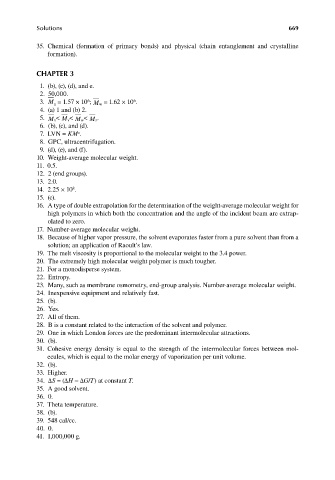Page 706 - Carrahers_Polymer_Chemistry,_Eighth_Edition
P. 706
Solutions 669
35. Chemical (formation of primary bonds) and physical (chain entanglement and crystalline
formation).
CHAPTER 3
1. (b), (c), (d), and e.
2. 50,000.
6 6
3. M = 1.57 × 10 ; Mw = 1.62 × 10 .
n
4. (a) 1 and (b) 2.
< < < .
5. Mn M v Mw Mz
6. (b), (c), and (d).
a
7. LVN = KM .
8. GPC, ultracentrifugation.
9. (d), (e), and (f).
10. Weight-average molecular weight.
11. 0.5.
12. 2 (end groups).
13. 2.0.
8
14. 2.25 × 10 .
15. (c).
16. A type of double extrapolation for the determination of the weight-average molecular weight for
high polymers in which both the concentration and the angle of the incident beam are extrap-
olated to zero.
17. Number-average molecular weight.
18. Because of higher vapor pressure, the solvent evaporates faster from a pure solvent than from a
solution; an application of Raoult’s law.
19. The melt viscosity is proportional to the molecular weight to the 3.4 power.
20. The extremely high molecular weight polymer is much tougher.
21. For a monodisperse system.
22. Entropy.
23. Many, such as membrane osmometry, end-group analysis. Number-average molecular weight.
24. Inexpensive equipment and relatively fast.
25. (b).
26. Yes.
27. All of them.
28. B is a constant related to the interaction of the solvent and polymer.
29. One in which London forces are the predominant intermolecular attractions.
30. (b).
31. Cohesive energy density is equal to the strength of the intermolecular forces between mol-
ecules, which is equal to the molar energy of vaporization per unit volume.
32. (b).
33. Higher.
34. ∆S = (∆H − ∆G/T) at constant T.
35. A good solvent.
36. 0.
37. Theta temperature.
38. (b).
39. 548 cal/cc.
40. 0.
41. 1,000,000 g.
9/14/2010 3:44:12 PM
K10478.indb 669 9/14/2010 3:44:12 PM
K10478.indb 669

